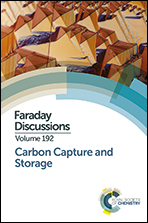Molecular simulation of the thermophysical properties and phase behaviour of impure CO2 relevant to CCS†
Abstract
Impurities from the CCS chain can greatly influence the physical properties of CO2. This has important design, safety and cost implications for the compression, transport and storage of CO2. There is an urgent need to understand and predict the properties of impure CO2 to assist with CCS implementation. However, CCS presents demanding modelling requirements. A suitable model must both accurately and robustly predict CO2 phase behaviour over a wide range of temperatures and pressures, and maintain that predictive power for CO2 mixtures with numerous, mutually interacting chemical species. A promising technique to address this task is molecular simulation. It offers a molecular approach, with foundations in firmly established physical principles, along with the potential to predict the wide range of physical properties required for CCS. The quality of predictions from molecular simulation depends on accurate force-fields to describe the interactions between CO2 and other molecules. Unfortunately, there is currently no universally applicable method to obtain force-fields suitable for molecular simulation. In this paper we present two methods of obtaining force-fields: the first being semi-empirical and the second using ab initio quantum-chemical calculations. In the first approach we optimise the impurity force-field against measurements of the phase and pressure–volume behaviour of CO2 binary mixtures with N2, O2, Ar and H2. A gradient-free optimiser allows us to use the simulation itself as the underlying model. This leads to accurate and robust predictions under conditions relevant to CCS. In the second approach we use quantum-chemical calculations to produce ab initio evaluations of the interactions between CO2 and relevant impurities, taking N2 as an exemplar. We use a modest number of these calculations to train a machine-learning algorithm, known as a Gaussian process, to describe these data. The resulting model is then able to accurately predict a much broader set of ab initio force-field calculations at comparatively low numerical cost. Although our method is not yet ready to be implemented in a molecular simulation, we outline the necessary steps here. Such simulations have the potential to deliver first-principles simulation of the thermodynamic properties of impure CO2, without fitting to experimental data.
- This article is part of the themed collection: Carbon Capture and Storage

 Please wait while we load your content...
Please wait while we load your content...